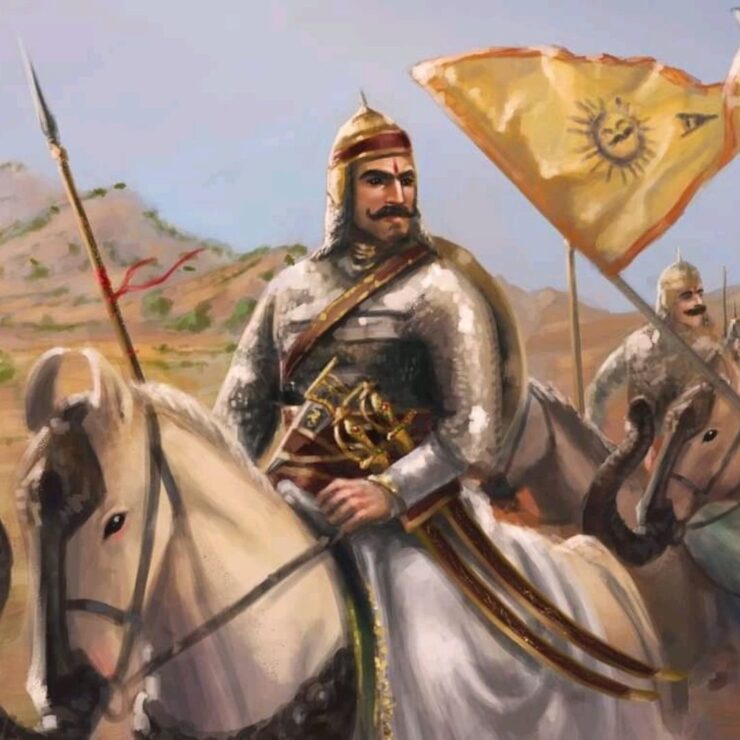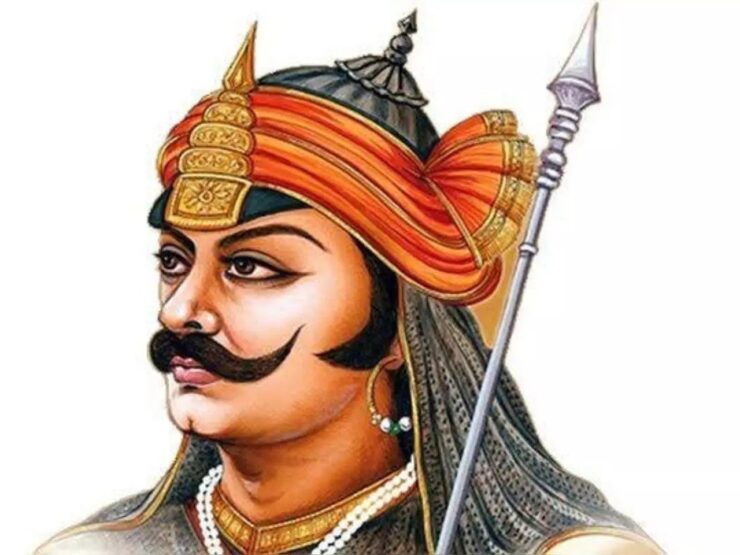
Maharana Pratap is a folk hero in India, especially in Rajasthan. He is recognised as the top Rajput ruler who strongly opposed the Mughal dynasty under Emperor Akbar. His military resistance against the expansionism of the Mughal empire through guerrilla warfare became a source of inspiration for later rebels against Mughals, including Shivaji.
Pratap Singh I, popularly known as Maharana Pratap, was a king of Mewar from the Sisodia dynasty. He was born to Udai Singh II and Jaiwanta Bai. His younger brothers included Shakti Singh, Vikram Singh and Jagmal Singh. Pratap also had two stepsisters – Chand Kanwar and Man Kanwar. Pratap was married to Ajabde Punwar of Bijolia and had 17 sons, including Amar Singh I, and five daughters.
After the death of Udai Singh in 1572, queen Dheer Bai wanted her son Jagmal to succeed as the Mewar ruler. However, senior courtiers preferred the eldest prince Pratap to be their king. The desire of the nobles prevailed. Pratap ascended the throne as Maharana Pratap, the 54th ruler of Mewar. Jagmal swore revenge and left for Ajmer to join the armies of Akbar. He obtained the Jagir of the Jahazpur town as a gift in return for his help to the Mughal forces.
Siege of Chittorgarh
The bloody siege of Chittorgarh in 1567-1568 led to the loss of the fertile eastern belt of Mewar to the Mughals. However, the rest of the wooded and hilly kingdom in the Aravalli range was still under the control of Maharana Pratap. Emperor Akbar wanted to secure a stable route to Gujarat through Mewar when Pratap Singh was crowned king (Maharana). In 1572, Akbar sent a number of envoys, including Raja Man Singh of Amer, entreating Maharana Pratap to become a vassal like many other rulers in Rajputana. When Maharana Pratap refused to submit to Akbar, war became inevitable.
The famous Battle of Haldighati was fought on June 18 in 1576 between Maharana Pratap and the Mughal forces led by Man Singh. The Mughals were victorious and inflicted significant casualties among the Mewaris but failed to capture Maharana Pratap. The site of the battle was a narrow mountain pass at Haldighati near Gogunda, modern-day Rajsamand in Rajasthan.
Maharana Pratap fielded a force of around 3000 cavalry and 400 Bhil archers. The Mughals were led by Man Singh who commanded an army numbering around 10,000 men. After a fierce battle lasting more than three hours, Maharana Pratap was wounded, but he managed to retreat to the hills and lived to fight another day.
Futile victory
Haldighati was a futile victory for the Mughals as they were unable to kill or capture any of Maharana Pratap’s family members. While Maharana Pratap was able to make a successful escape, Man Singh managed to conquer Gogunda a week after Haldighati and then ended his campaign. Subsequently, Akbar himself led a sustained campaign against Maharana Pratap in September 1576 and soon, Mughals controlled Gogunda, Udaipur and Kumbhalgarh.

However, the Mughal pressure on Mewar relaxed after 1579 following rebellions in Bengal and Bihar and Mirza Hakim’s incursion into Punjab. Akbar did send Abdul Rahim Khan-i-Khanan to invade Mewar but he stopped at Ajmer.
In 1582, Maharana Pratap attacked and occupied the Mughal post at Dewar in the Battle of Dewar. This led to the automatic liquidation of all 36 Mughal military outposts in Mewar. After this, Akbar sent Jagannath Kachhwaha to invade Mewar in 1584. In 1585, Akbar moved to Lahore and remained there for the next 12 years watching the situation in the northwest. No major Mughal expedition was sent to Mewar during this period.
Taking advantage of the situation, Maharana Pratap recovered most of Mewar except its former capital Chittorgarh and the Mandalgarh and Vagad regions by defeating Mughal forces. He also built a new capital, Chavand, near modern Dungarpur.
Hunting accident
According to some sources, Maharana Pratap died of injuries sustained in a hunting accident at Chavand on January 19 in 1597 at the age of 56. He was succeeded by his eldest son Amar Singh I. On his death bed, Maharana Pratap told his son never to submit to the Mughals and to win Chittor back.
Even to this day, Maharana Pratap is a celebrated figure and is admired in the country. There is a Maharana Pratap statue in Udaipur. In fact, not only Maharana Pratap is a prominent figure in the folk and contemporary Rajasthani culture, even his horse Chetak has entered folklore. The train from Delhi to Udaipur is known as the Chetak Express.
– The writer is a senior journalist and media consultant. The views expressed are of the writer and do not necessarily reflect the views of Raksha Anirveda








